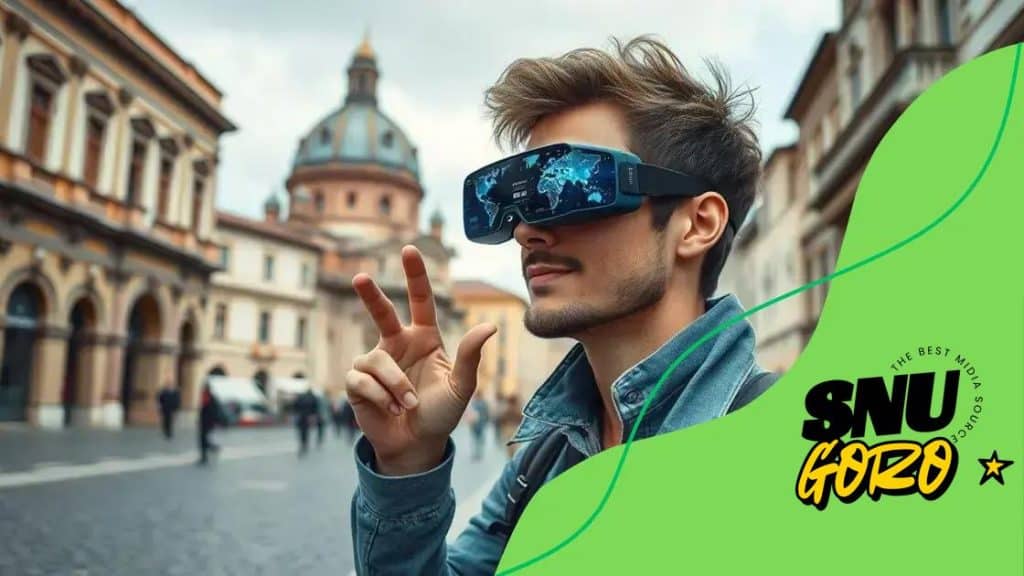Augmented reality in tourism experiences: a new frontier

Augmented reality in tourism enhances travel experiences through interactive content, personalized insights, and improved navigation, creating engaging narratives and gamified exploration for travelers.
Augmented reality in tourism experiences is changing the way we explore the world around us. Imagine walking through a historic site and seeing it come to life through your device, enhancing your understanding and enjoyment. Ready to dive into how this technology can transform your travels?
Understanding augmented reality in tourism
Understanding augmented reality in tourism connects travelers to their destinations in an exciting way. It combines real-world sights with digital information to enhance the experience.
What is Augmented Reality?
Augmented reality (AR) integrates digital elements into the physical world. Unlike virtual reality, which creates a completely digital environment, AR allows users to see real-world scenery with added layers of information. For instance, while visiting a historic monument, travelers can use their devices to see reconstructions of how it looked in the past.
Benefits of AR in Tourism
The use of AR in tourism provides several key benefits:
- Enhanced Learning: Tourists can absorb information about sites through interactive features.
- Engagement: The technology makes experiences more engaging, capturing attention and prompting exploration.
- Personalization: AR applications can offer tailored information based on individual interests.
Many attractions now use AR to enrich visitors’ understanding and enjoyment. For example, museums often employ augmented reality exhibits to bring artifacts to life, making history feel tangible. This can lead to a more immersive visit that conveys stories that might otherwise be overlooked.
As technology evolves, so do the ways AR can transform tourism. From navigation aids highlighting points of interest to detailed historical reenactments that unfold before your eyes, the possibilities are vast. Additionally, AR can cater to various languages and backgrounds, making the experience accessible to a broader audience.
Challenges in Adoption
While there is much excitement, implementing augmented reality in tourism does come with challenges. Some destinations may face technical difficulties, especially in integrating AR seamlessly into existing infrastructures. Furthermore, the need for smartphone access raises concerns about inclusivity for those without the latest devices.
Despite these challenges, the potential for augmented reality in tourism continues to grow. As barriers are addressed, we can expect an exciting evolution in how we experience travel, combining the physical world with engaging digital content.
Benefits of augmented reality for travelers
Benefits of augmented reality for travelers highlight how this technology enhances travel experiences. With augmented reality, travelers gain more than just visual appeal; they receive engaging information that makes every trip memorable.
Interactive Experiences
One major advantage is the interactive nature of augmented reality. Instead of passively viewing sites, travelers can interact with their surroundings. For instance, AR apps allow users to point their devices at landmarks and receive instant, interactive information.
Personalized Insights
Augmented reality also offers personalized insights that cater to individual interests. Travelers can select themes or preferences, allowing the app to showcase attractions that match their tastes. This level of personalization means that every travel experience can be unique and tailored.
- Custom Routes: Design routes based on interests like food, history, or art.
- Language Options: Access information in multiple languages for better understanding.
- Specialized Tours: Participate in guided tours that focus on specific themes.
Additionally, augmented reality can provide information on lesser-known attractions. Sometimes, hidden gems are overshadowed by popular sites. With AR, travelers can discover and learn about these unique spots. This exploration can lead to unforgettable adventures that might not be found in typical guidebooks.
Beyond entertainment, augmented reality enhances learning experiences. When visiting museums, for example, AR applications can show historical events or figures in context, making it easier to grasp the significance of what you’re seeing. By providing context, AR turns a simple visit into an educational journey.
Enhancing Navigation
Another benefit is enhanced navigation. Many AR apps now feature real-time directions that overlay on the actual street view. This makes it easier for travelers to find their way without getting lost. These overlays can also highlight nearby restaurants, shops, and attractions, helping tourists discover more within their surroundings.
As augmented reality continues to evolve, the combination of technology with travel creates endless possibilities. Travelers today can expect richer experiences, deeper insights, and a more connected journey that blends the best of both worlds.
Innovative examples of augmented reality applications

Innovative examples of augmented reality applications show how businesses and organizations use this technology to enhance experiences. Across various sectors, AR is making a significant impact, especially in tourism.
Virtual Tours
Some museums and historical sites employ augmented reality to offer virtual tours. Visitors can point their devices at exhibits and see additional content, such as videos and stories, unfold right before their eyes. This makes learning more interactive and engaging.
- Real-Time Annotations: AR can display annotations when viewing an object, offering insights and background information.
- 3D Models: Visitors might see 3D reconstructions of artifacts, providing context about their origins.
- Guided Paths: AR can guide guests through complex exhibitions, ensuring they don’t miss important stops.
In addition to museums, many travel apps utilize augmented reality. For example, when travelers aim their smartphones at city landmarks, they can receive historical facts, menus from nearby restaurants, or even user reviews. This immediate access to information can greatly aid their decision-making.
Gaming and Entertainment
AR isn’t limited to cultural experiences alone. The gaming sector has adopted AR to create immersive experiences. Games like Pokémon GO allow players to engage in outdoor exploration, capturing virtual creatures in real-world settings. This merging of reality and gaming keeps players active while providing entertainment.
Furthermore, sports events have begun to use augmented reality to enhance viewer engagement. During broadcasts, viewers can access stats superimposed over live video feeds, bringing more depth to the experience. Fans can see player stats, game summaries, and tactical analyses in real time.
AR Navigation
In urban environments, augmented reality apps are revolutionizing navigation. By offering real-time navigation overlays on street views, travelers can see directions without taking their eyes off their path. This helps reduce distractions and improves safety.
Such AR applications often include points of interest along the way, suggesting cafes or shops nearby. This added layer provides travelers with options they might otherwise miss, enriching their journey.
Overall, the use of augmented reality applications in various fields demonstrates its potential to enhance experiences in powerful ways. As technology continues to develop, we can expect even more innovative applications that will redefine how we interact with our surroundings.
Challenges in implementing augmented reality in tourism
Challenges in implementing augmented reality in tourism can create barriers for achieving its full potential. While augmented reality (AR) offers remarkable benefits, several hurdles need to be overcome.
Technological Limitations
One significant challenge is the technological limitations present in some areas. Not all smartphones or devices support the latest AR applications, which can restrict access for travelers. Additionally, poor internet connectivity can hinder the functionality of apps, making them less effective.
High Development Costs
The costs associated with developing AR content can be substantial. Creating engaging and accurate AR experiences often requires skilled developers and designers. Smaller businesses and attractions might struggle to allocate the necessary budget to create these technologies.
- Content Creation: Producing high-quality AR experiences often involves extensive research and design.
- Maintenance: Keeping AR applications updated and relevant is an ongoing expense.
- Hardware Upgrades: Frequent updates may necessitate hardware upgrades for optimal performance.
Alongside financial concerns, there are usability issues that can hinder the adoption of AR. Travelers may find it challenging to interact with AR applications if they are not user-friendly. If an app is complicated, users might avoid utilizing it altogether, resulting in a missed opportunity for enhancing their experience.
Privacy Concerns
Privacy is another pressing challenge. Many AR applications require access to location data and personal information. This can lead to concerns among users about their privacy and data security. Without proper assurance, some travelers may hesitate to engage with AR tools.
Moreover, the perception of augmented reality can vary across cultures. Some travelers may be unfamiliar with the technology and view it with skepticism. Convincing them of the benefits of AR is crucial to ensuring widespread acceptance.
Despite these challenges, the potential of augmented reality in tourism remains vast. Addressing these hurdles can pave the way for a more integrated and engaging travel experience.
Future trends in augmented reality for travel
Future trends in augmented reality for travel are set to reshape the way we explore the world. As technology continues to advance, augmented reality (AR) will likely play a growing role in creating more immersive experiences for travelers.
Increased Integration with AI
One promising trend is the deeper integration of AR with artificial intelligence (AI). This combination can enhance personalization in travel experiences. For instance, AI could analyze user preferences and tailor AR content to their interests, making every journey unique.
Advanced Navigation Systems
Future AR applications are expected to enhance navigation systems significantly. Imagine walking through an unfamiliar city while your device provides seamless directions overlaid on your environment. Travelers will be guided to points of interest without needing to search for information actively.
- Context-Aware Information: Provide information based on the traveler’s location and past activities.
- Interactive Maps: Offer dynamic maps that adjust to real-time conditions.
- Social Sharing: Enable easy sharing of AR experiences with friends and family.
Moreover, travel companies are likely to develop AR experiences that accurately reflect local cultures. Using AR applications, travelers can receive lessons on historical events or cultural customs while visiting a site. This education fosters a deeper connection to the places they visit.
Enhanced Storytelling
Another trend is the growth of augmented reality storytelling. With AR, travel experiences can transcend the physical world and become interactive narratives. Museums and tours may incorporate AR to bring historical events to life, allowing visitors to witness moments as they unfold.
As storytelling evolves, so too will travelers’ engagement. By blending interactive elements, AR can captivate audiences and make learning enjoyable. For example, while visiting a historical site, tourists could experience reenactments through their devices, making the past feel alive.
Gamification of Travel
Gamification will also become more prevalent in AR applications. Travelers may earn rewards or achievements for engaging with specific locations or completing challenges via AR. This can motivate exploration and create a sense of adventure.
As the technology improves, the quality of AR experiences will become more realistic and engaging. Augmented reality for travel is entering an exciting new phase, and industry leaders are eager to harness its potential to revolutionize how we experience the world around us.
FAQ – Frequently Asked Questions about Augmented Reality in Tourism
What is augmented reality and how is it used in tourism?
Augmented reality (AR) is a technology that blends digital content with the real world. In tourism, it enhances experiences by providing interactive information about landmarks, attractions, and culture.
What are the benefits of using AR in travel?
AR offers various benefits, including personalized experiences, enhanced navigation, and engaging storytelling, making travel more interactive and informative.
What challenges do businesses face when implementing AR?
Businesses may face challenges such as high development costs, technological limitations, and privacy concerns that can affect user trust and engagement.
What are some future trends for AR in tourism?
Future trends include deeper integration with AI for personalized content, advancements in navigation systems, enhanced storytelling, and gamification to engage travelers.





